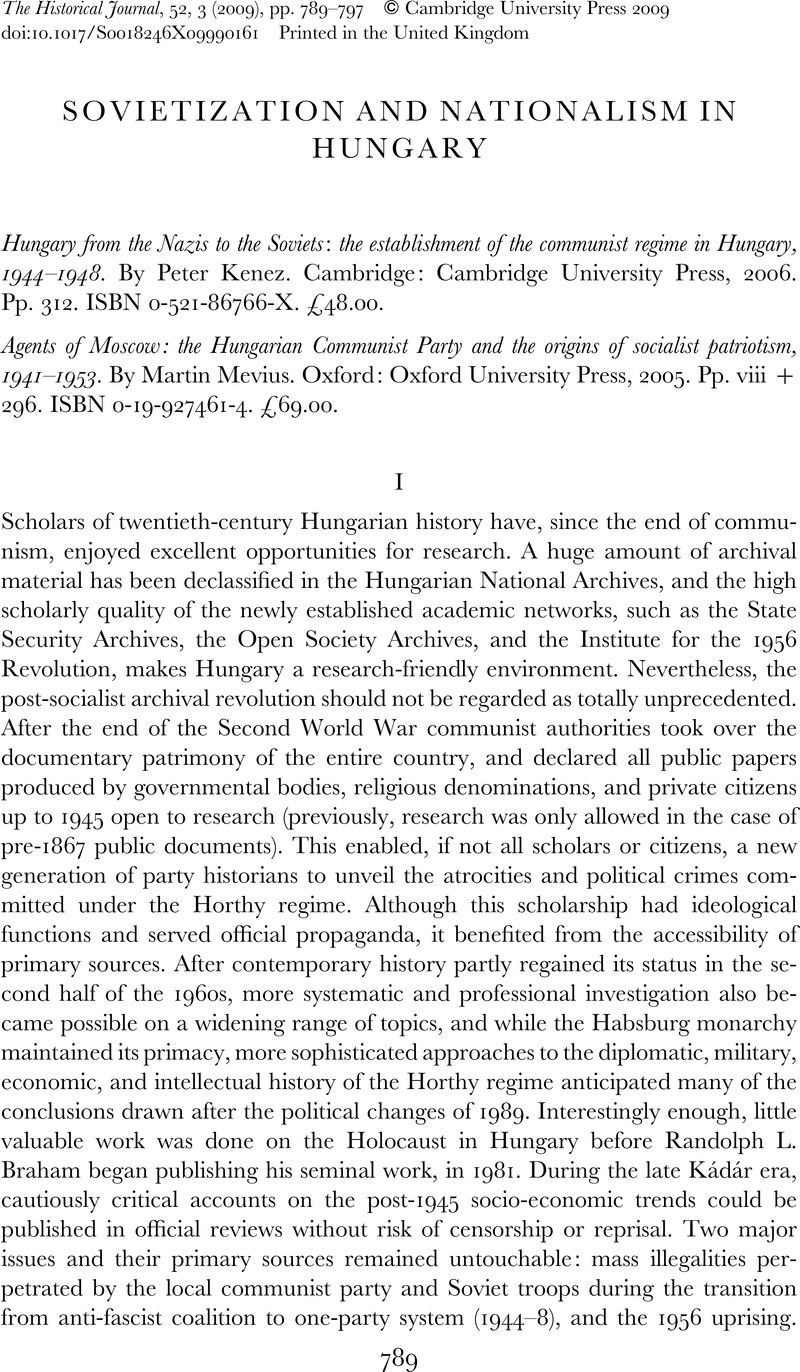Article contents
SOVIETIZATION AND NATIONALISM IN HUNGARY
Published online by Cambridge University Press: 04 August 2009
Abstract

- Type
- Review Articles
- Information
- Copyright
- Copyright © Cambridge University Press 2009
References
1 On the creation of the Soviet external empire, see among others F. Gori and S. Pons (eds.), The Soviet Union and Europe in the Cold war, 1943–1953 (London, 1996); Eduard Mark, Revolution by degrees: Stalin's national front strategy for Europe, 1941–1947 (Washington, DC, 2001); and the more recent Fabio Bettanin, Stalin e l'Europa: la formazione dell'impero esterno sovietico, 1941–1953 (Rome, 2007).
2 István Bibó, Válogatott tanulmányok: második kötet 1945–1949 (Budapest, 1986). Some of those essays have also appeared in an English edition, Károly Nagy (ed.), Democracy, revolution, self-determination (New York, NY, 1991).
3 Johanna C. Granville, The first domino: international decision making during the Hungarian crisis of 1956 (College Station, TX, 2004).
4 Csaba Békés, Európából Európába: Magyarország konfliktusok kereszttüzében, 1945–1990 (Budapest, 2004), p. 51.
5 Krisztián Ungváry, Battle for Budapest: one hundred days in World War II, trans. L. Löb (London, 2003; Hungarian edition 1998).
6 On the expulsion of Swabians and its collective memory see Ágnes Tóth, Hazatértek: a németországi kitelepítésből visszatért magyarországi németek megpróbáltatásainak emlékezete (Budapest, 2008).
7 On the characterological debate, see Balázs Trencsényi: A történelem rémülete: eszmetörténeti vázlat a két világháború közötti kelet-európai nemzetkarakterológiai vitákról, in Iván Zoltán Dénes, ed., A szabadság értelme – az értelem szabadsága: filozófiai és eszmetörténeti tanulmányok (Budapest, 2004), pp. 299–324.
8 Róbert Győri Szabó, A kommunista párt és a zsidóság Magyarországon, 1945–1956 (Budapest, 1997); János Gyurgyák, A zsidókérdés Magyarországon (Budapest, 2001) and Ezzé lett magyar hazátok. A magyar nemzeteszme és nacionalizmus története (Budapest, 2007). On the post-war anti-Semitism see Éva Standeisky, Antiszemitizmusok (Budapest, 2007); and András Kovács, A másik szeme: zsidók és antiszemiták a háború utáni Magyarországon (Budapest, 2008). On Jewish victims of the early communist regime see Ágnes Szalai, ‘A magyarországi kommunista diktatúra zsidó áldozatai (1949–1954)’, in Randolph L. Braham, ed., Tanulmányok a Holokausztról IV (Budapest, 2006), pp. 217–68.
9 Charles Gati, Failed illusions: Moscow, Washington, Budapest, and the 1956 Hungarian revolt (Stanford, CA, 2006).
- 2
- Cited by




